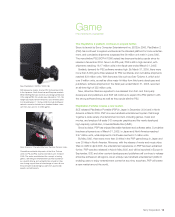Sony 2005 Annual Report Download - page 25
Download and view the complete annual report
Please find page 25 of the 2005 Sony annual report below. You can navigate through the pages in the report by either clicking on the pages listed below, or by using the keyword search tool below to find specific information within the annual report.
Sony Corporation 23
R&D Strategies and Selection of Key Technological Fields
Cell—the next-generation processor
Research and development (R&D) are vital to achieving the continuous innovation
crucial to sustained corporate growth. After identifying key technological fields and
R&D themes with the potential to deliver growth, Sony manages its R&D activities
strategically to differentiate and increase the value-added components of its products
and services. While Sony naturally directs efforts toward technologies that sustain
and develop its current businesses, it also examines technologies that will create new
markets and give consumers fresh lifestyle ideas.
As we progress into the era of broadband networks, it is increasingly important to
create environments that facilitate the enjoyment of high-definition (HD) images and
other high-grade audiovisual content inside and outside the home. The key to realiz-
ing such environments is the home server, which is used to control both networked
audiovisual equipment and the content recorded or purchased by the consumer. We
recognize semiconductors, displays and storage technologies as essential to making
home servers and the connected audiovisual equipment better, easier to use, and
more feature-packed. Accordingly, we will concentrate our R&D activities on these
three key technological fields for the foreseeable future.
R&D Results for the Fiscal Year Ended March 31, 2005
Semiconductors
Electronics products derive the majority of their value-added, advanced features from
semiconductor devices. Accordingly, Sony has made semiconductor technologies a
key focus and is active in semiconductor design and process technology research,
as well as the development of high-performance, high-function devices closely linked
to products.
•Cell—The Next-Generation Processor
At the International Solid-State Circuits Conference (ISSCC) in February 2005, the Sony
Group, IBM Corporation and Toshiba Corporation revealed Cell, a high-performance
processor under joint development since March 2001. Built on a revolutionary new
multicore architecture, Cell features eight floating-point computing cores and a Power-
based processor core, achieving clock speeds exceeding 4GHz and supercomputer-level
floating-point computing performance. We will incorporate Cell into next-generation
audiovisual equipment, including computer entertainment systems, home servers and
digital televisions. We also plan to continue developing this processor to achieve break-
through advances in performance for real-time processing of rich media applications.
•1080i Standard HD CCD
Drawing on our proprietary imaging device technologies, we developed the first
consumer-use HD charge-coupled device (CCD) capable of supporting 1080 interlaced
(1080i) digital HD photography at a 16:9 aspect ratio.* In addition to paving the way
for high-resolution imaging with a total count of 1.12 million pixels, the 1080i standard
HD CCD attains excellent sensitivity and smear performances.** The new device is
being incorporated into the HDR-FX1, the first consumer-use digital HD video camera
recorder based on the 1080i standard.
**The aspect ratio is a display’s width-to-height ratio.
** Smear is the effect created when strong incident light, such as sunlight, strikes the CCD sensor,
causing perpendicular white stripes to appear on the screen.
S ONY AR -E 0629 Adobe PageMaker 6.0J /PPC
























